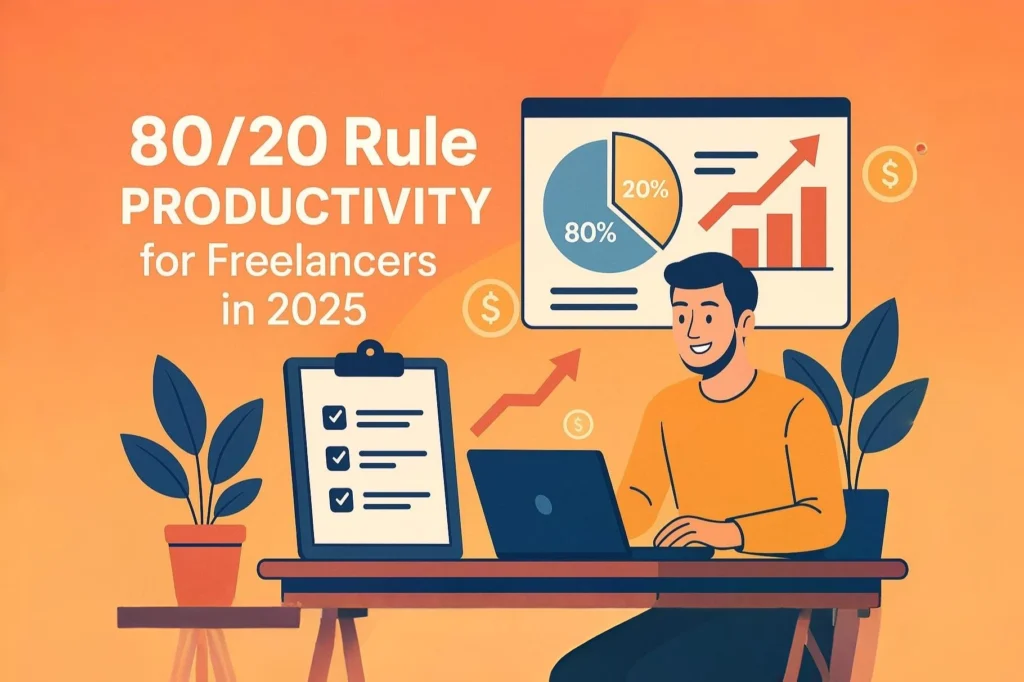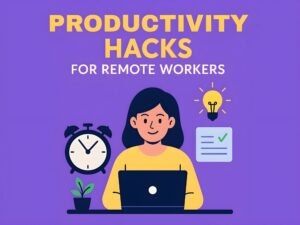80/20 Rule Productivity for Freelancers in 2025
The 80/20 rule productivity for freelancers is becoming a powerful strategy in 2025. With more remote professionals and solo workers managing their own schedules, understanding how to work smarter, not harder, is the new competitive edge. In this guide, we’ll show how applying the 80/20 rule—also known as the Pareto Principle—can revolutionize how freelancers approach tasks, prioritize clients, and increase profits.
What is the 80/20 Rule?
The 80/20 principle — actually the Pareto Principle — is quite possibly the most helpful productivity principle available for freelancers to use. Basically, it claims that around 80% of outcomes come from just 20% of efforts. This effect is seen everywhere: in commerce, 80% of profits often come from 20% of clients; in time management, 80% of important progress usually comes from 20% of focused effort.
But this is not theory — it’s a frame for better decision-making. If you’re continually busy yet never getting ahead, the 80/20 rule productivity for freelancers works to pause and reflect on: which specific actions or clients are really making a difference? It’s not a matter of doing more — it’s a matter of doing more of what works.
For freelancers, this can be a big breakthrough. You may discover that a handful of activities (like pitching to high-quality leads, or working on optimizing your portfolio) are where all of your success lies. While the time you spend on doing tiny admin tasks, or minuscule gigs that pay poorly, isn’t worth your time. Seeing that discrepancy means that you can focus your energy where it will matter — and cut out what won’t further your long-term goals.
The beauty of the 80/20 principle is that it’s flexible to your process. It’s not a formula, but a mindset. The precise percentages aren’t necessary — there are days when it’s 70/30, or 90/10. What matters is to know that everything isn’t created equal, and how to prioritize ruthlessly. For freelancers dealing with multiple clients, deadlines, and distractions, this approach adds clarity, concentration, and better result with less burnouts.
Real-Life Freelancer Case Studies Implementing the 80/20 Rule
To witness the power of the 80/20 principle in an everyday life of a freelancer, let’s look at some practical examples. These anecdotes show how professionals across different industries—writing, design, consulting, and coding—apply the 80/20 principle to double their revenues, stop burnout, and focus on what really produces results. From discovering lucrative clients to avoiding busywork, these freelancers show what is possible when you work smarter rather than harder.
Case Study 1: The Designer Who Doubled Her Income
Sarah, a UX designer, observed that two of her long-term customers contributed to over 70% of her monthly revenue while the others created scope creep and time wastage without end. She leaned in more on taking care of the two clients, raised her rates slightly, and got rid of the low-revenue ones. Her revenue doubled within six months with fewer working hours. Her strategy? Prioritize high-performing customers and reject distractions.
Case Study 2: The Copywriter Who Cut Admin Time by 80%
Mike is a freelance copywriter who tracked his work and discovered that most of his income was from content writing for websites. But 30% of his week was spent on emails, invoicing, and social media with no ROI. By shifting to Toggl time-tracking and hiring a virtual assistant, he regained 10+ hours a week to spend on his highest-grossing offers—nearly doubling his client base within less than a year.
Case Study 3: The Developer Whose Workflow He Automated
Raj, a freelance developer, found that most of his high-paying work was WordPress troubleshooting projects, but he was wasting time doing extraneous technical projects. By establishing an automation system and email templates for running issues and eliminating low-value projects, he reduced his weekly work hours from 50 to 32 and boosted profits by 40%. He also recommends using Zapier to automate repetitive tasks.
Common Mistakes When Applying the Rule
While the 80/20 rule is simple in theory, many freelancers apply it incorrectly or abandon it too early. Here are common pitfalls to avoid:
- Confusing busyness with productivity: Just because you’re working all day doesn’t mean you’re producing high-value outcomes. Always analyze what’s truly delivering results.
- Focusing on short-term wins: Don’t just drop clients who aren’t profitable this month. Consider long-term growth, referrals, and reputation.
- Over-automating: Tools are great, but dismissing human touch while interacting with clients or generating content could bring about a return.
- Not reviewing on a regular basis: The 80/20 rule may shift over time. It is good to make it a routine to review every month in order to stay on top of your most lucrative work.
For more advanced time tips, see our article: 10 Time Management Hacks Every Remote Worker Needs in 2025.
Taking the 80/20 Rule Even Further
By this point, you’ve already discovered how 80/20 rule productivity as a freelancer can completely transform your work. But if you’re looking to get the most out of its true potential, it’s time to take it up a notch beyond mere identification of high-leverage tasks or clients. The next level is maximizing *how* and *when* you do the highest-value work. One proven strategy is batching—especially for your highest-value tasks.
Batching isn’t just a time management trend—it’s a neuroscience-backed technique that allows your brain to slip into a state of hyperfocus. Instead of flipping back and forth between tasks (increasing cognitive load and stress), you batch tasks together and allocate separate blocks of time to them. This reduces friction and energy wasted on switches.
For freelancers employing the 80/20 rule, this is a game changer. Your highest value tasks—the 20% that yield 80% of your result—require single-minded focus. So instead of diluting them throughout the week, batch them in focused blocks where you can give them the energy they deserve.
Here’s a brief example: Let’s say you have three high-paying clients who bring in most of your business. Rather than doing their work in isolated chunks throughout the week, take Monday and Tuesday mornings for them only. That creates a rhythm. Your brain knows what to do, and you start building “momentum zones.”
To make batching work for you:
Audit Your Calendar: Identify when you usually have the most focus (e.g., mornings, mid-week).
Time-Block Strategically: Allocate high-priority activities to those blocks. Label them clearly (e.g., “Deep Work – Client A Proposal”).
Eliminate Distractions: Turn off notifications, use a Pomodoro timer, or listen to focus-enhancing music like Brain.fm during these periods.
Use Templates and Systems: For repetitive tasks (invoices, pitches, email follow-ups), set up templates to batch them even faster.
If done consistently, batching creates efficiency loops. You get substantial work done in fewer hours and also avoid decision fatigue. It even gains clients’ trust who love your enhanced output and faster turnaround. And since you’re not exerting energy on repeated task-switching, you’ll also feel less tired at the end of the day—still delivering better results.
Want a nudge to get started? Try using Motion or Notion to schedule your time blocks visually. Both apps let you create repeating events, and you can even color-code your “80/20” areas so you can spot them at a glance. Additional productivity hacks also await you in our in-depth guide: 10 Time Management Hacks Every Remote Worker Needs in 2025.
Remember, batching is not about working more—it’s about working better. Mix the 80/20 rule with time-blocking strategies and design a flow that is productive to depth without burnout. It’s what all-star freelancers do to transition from diffuse and frazzled to focused and profitable.
Use Client Scoring Systems:
One of the brightest applications of the 80/20 rule productivity for freelancers is by grading your clients. This isn’t favoritism—it’s making decisions based on facts that will aid your development. When you grade your clients on an organized system, you’ll have it in black and white which accounts have the highest return on your business and which ones are sucking away your time, energy, or profitability.
Here’s how to create a basic but effective client scoring system based on the following key factors:
Revenue Potential (1–5): How much monthly or per-project income does this client bring in? More lucrative clients should get higher marks.
Communication & Reliability (1–5): Are they a pleasure to work with? Do they meet deadlines and offer clear directions?
Repeat Work or Long-Term Value (1–5): Do they offer repeated work, or is this a single task? Are they going to return or recommend you?
Project Enjoyment or Alignment (1–5): Is the work within your skill set and strengths and something you enjoy? Or outside of your skill set and draining to complete?
Growth Opportunity (1–5): Does this client expose you to a larger network, portfolio projects, or learning factors?
Once you have scored, add up each client’s points. You will start noticing patterns. Clients who are 20 or above are your VIPs—they are your top 20% and need to be prioritized. Clients who are below 12? They may be in your bottom 80% that are occupying most of your time without generating enough ROI.
This exercise allows you to make smart decisions on:
Which clients to prioritize, upsell, or sell retainer packages to
Which customers to phase out or replace with more profitable ones over time
Where to focus your marketing and outreach efforts to get more customers like your best customers
To take it even further, experiment with assigning weighted scores according to your priorities. For example, if you value recurring revenue over big one-off payments, weigh long-term potential more heavily in your scoring.
It may sound like a cold approach, but remember: your time and energy are limited. Treating your freelance business like a business means making strategic decisions—not just emotional ones. By regularly reviewing and updating your client scores (quarterly or even monthly), you’ll stay focused on what truly drives your success.
Pro tip: Use software like Airtable or Notion to create dynamic client databases where you can keep track of scores, notes, and track client performance over time.
Conclusion
Used wisely, the 80/20 rule productivity for freelancers system can completely transform your freelance business. By understanding the handful of tasks, clients, and projects that deliver the most output—and cutting the rest loose—you have more control, more time, and more cash.
Don’t be hectic—be effective. Let this be your 2025 and more freelancing slogan.
Additional Time-Saving Hacks?
Stay tuned by subscribing to our newsletter for weekly productivity hacks, remote working tips, and freelance earning strategies for today’s digital workers.
Find more guides like these:
How to Work with Multiple Clients as a Freelancer in 2025
Remote Work Setup Checklist in 2025
Secret Money-Making Features Hidden Within Apps You Already Have




